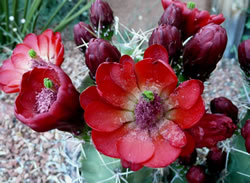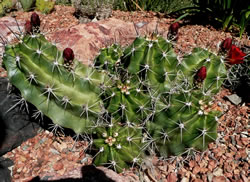Plant of the Week
 Echinocereus triglochidiatus range map. USDA PLANTS Database.
Echinocereus triglochidiatus range map. USDA PLANTS Database.
 Close-up of kingcup cactus flowers. Photo by Charlie McDonald.
Close-up of kingcup cactus flowers. Photo by Charlie McDonald.
 Kingcup cactus in a cactus garden in Albuquerque, New Mexico. Photo by Charlie McDonald.
Kingcup cactus in a cactus garden in Albuquerque, New Mexico. Photo by Charlie McDonald.
Kingcup Cactus (Echinocereus triglochidiatus)
By Charlie McDonald
Kingcup cactus is in the cactus family (Cactaceae), which is a group of about 350 species. These plants are all native to the New World.
The cacti have always been difficult to name and classify and Kingcup cactus is a good example of why. Kingcup cactus is in a group of cacti often called the claret cups. These cacti differ strikingly across their range with some of them having many dense spines and others being almost completely spineless. As a result, many varietal names have been published in the scientific literature and just about as many common names are found in various publications. The common names include claret cup, claret cup hedgehog, curve-spine claret cup, kingcup cactus, king's crown cactus, spineless hedgehog, strawberry cactus, mound cactus, mound hedgehog cactus, crimson hedgehog, Mojave hedgehog, Mojave kingcup cactus, and Mojave mound cactus.
Recent knowledge about chromosome numbers has either helped clarify the naming issue or has added to the confusion depending on your point of view. Some of the claret cup cacti have 22 chromosomes and others are tetraploid having 44 chromosomes. The plants with 44 chromosomes are now considered to be scarlet hedgehog cactus (Echinocereus coccineus). This has helped botanists untangle some of the confusion, but is of little benefit when you are just looking at plants in nature.
Kingcup cactus is widely cultivated for its flowers and is among the easiest of the cacti to grow. Like all cacti, it needs good drainage and requires strong sunlight to maintain a healthy appearance. A harsh "dry and cool" winter environment combined with maximum light exposure enhances spring flower production.

